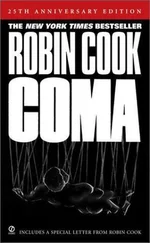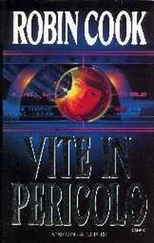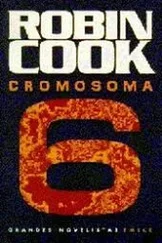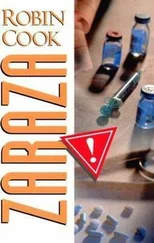The grand gallery sloped upward at the same ratio as the ascending passage. With its corbeled ceiling over twenty feet high, it was pleasantly spacious after the narrow confines of the corridor. To Erica’s right a grating covered the entrance to the descending shaft, which connected to the underground burial chamber. Ahead of her was the opening she wanted. Erica bent over again and entered the long horizontal corridor leading to the Queen’s Chamber.
Once there, she was again able to stand upright. The air was stuffy, and Erica remembered her uncomfortable feelings in Seti I’s tomb. She closed her eyes and tried to collect her thoughts. The room was without decoration, as were all the interior walls of the pyramid. She took out her flashlight and ran it around the room. The ceiling was vaulted in a chevron formation with huge slabs of limestone.
Erica opened her Baedeker to the schematic of the pyramid. She tried again to imagine what an architect like Nenephta would think if he were within the Great Pyramid, keeping in mind that even in his day the structure was over a thousand years old. From the diagram she knew that standing in the Queen’s Chamber she was directly above the original burial chamber and below the King’s Chamber. It was during the third and final modification of the pyramid that the burial chamber was designed higher in the structure. The new room was labeled King’s Chamber, and Erica decided it was time to visit it.
Bending over to enter the low passage back to the grand gallery, Erica saw that a figure was coming toward her. Passing someone in the narrow corridor would have been difficult, so she waited. With the exit momentarily blocked, she felt a rush of claustrophobia. Suddenly she was aware of the thousands of tons of rock above her. She closed her eyes, breathing deeply. The air was heavy.
“Christ, it’s just an empty room,” complained a blond American tourist. He wore a T-shirt that said “Black holes are out of sight.”
Erica nodded, then started down the tunnel. When she reached the grand gallery, it was already crowded. She climbed to the top behind an obese German man and mounted the wooden steps to get to the level of the King’s Chamber passage. Then she had to duck under a low wall. The grooves for huge sealing portcullises were visible on the sides.
Erica found herself in a pink granite room about fifteen by thirty feet. The ceiling was made from nine slabs laid horizontally. In one corner was a badly damaged sarcophagus. There were about twenty people in the room, and the air was oppressive.
Again Erica tried to imagine how the structure would suggest a way to thwart tomb robbers. She examined the area of the portcullises. Perhaps that was what Nenephta meant: granite closure of the tomb. But portcullises had been used in many of the pyramids. There was nothing unique about those in the Great Pyramid. Besides, they had not been used in the Step Pyramid, and Nenephta said that the way had been used in both.
Although the King’s Chamber was a good-sized room, it was certainly not large enough to store all the funerary possessions of a pharaoh of the importance of Khufu. Erica reasoned that the other chambers had probably been used for the pharaoh’s treasures, particularly the Queen’s Chamber, which was below her, and perhaps even the grand gallery, although many Egyptologists suggested that the grand gallery was constructed to store the sealing blocks for the ascending passage.
Erica had no idea how to explain Nenephta’s comments. As with all its other mysteries, the Great Pyramid remained mute. More and more people pressed into the King’s Chamber. Erica decided she needed some air. She put away her guidebook, but before leaving the chamber she wanted to see the sarcophagus. Gently pushing her way across the room, she peered into the granite box. She knew there was a good deal of controversy about its origin, age, and purpose. It was quite small to accommodate the royal coffin, and a number of Egyptologists doubted that it was a sarcophagus at all.
“Miss Baron…” a high-pitched but resonant voice said softly.
Erica turned, stunned to hear her name. She scanned the people nearest her. No one seemed to be looking at her. Then she glanced down. An angelic-looking boy of about ten, wearing a soiled galabia, was smiling at her.
“Miss Baron?”
“Yes,” said Erica hesitantly.
“You must go to the Curio Shop to see the statue. You must go today. You must go alone.”
The boy turned and disappeared into the crowd of people.
“Wait?” called Erica. She pushed her way through the crowd and looked down the sloping grand gallery. The boy was already three-quarters of the way down. Erica began the descent, but the wooded ribs were more difficult to handle going down than coming up. The boy seemed to have no trouble, and quickly disappeared into the opening of the ascending passageway.
Erica slowed to a safe speed. She knew she’d never catch him. She thought about his message and felt a rush of excitement. The Curio Shop! Her ruse had succeeded. She’d found the statue!
LUXOR 12:00 P.M.
With a violent tug Lahib Zayed felt himself pulled to his feet. Evangelos had an iron grip on the front part of his galabia. “Where is she?” he growled into the Arab’s frightened face.
Stephanos Markoulis, dressed casually in an open-necked shirt, put down the small bronze figure he’d been examining and turned to the two men. “Lahib, I cannot understand why, after letting me know Erica Baron came into your shop asking for the Seti statue, you hesitate to tell me where she is.”
Lahib was terrified, uncertain who scared him the most, Muhammad or Stephanos. But feeling Evangelos’ fingers tighten on his galabia, he decided it was Stephanos. “All right, I’ll tell you.”
“Let him go, Evangelos.”
The Greek released his grip abruptly so that Lahib staggered backward before regaining his balance.
“Well?” asked Stephanos.
“I don’t know where she is at the moment, but I know where she is staying. She has a room at the Winter Palace Hotel. But, Mr. Markoulis, the woman will be taken care of. We have made arrangements.”
“I would like to take care of her myself,” said Stephanos. “To be sure. But don’t worry, we’ll be back to say good-bye. Thanks for all your help.”
Stephanos motioned to Evangelos, and the two men walked out of the shop. Lahib did not move until they had gone from view. Then he ran to the door and watched them until they had disappeared.
“There is going to be big trouble here in Luxor,” said Lahib to his son when the two Greeks were out of sight. “I want you to take your mother and sister to Aswan this afternoon. As soon as the American woman appears and I give her the message, I’ll join you. I want you to go now.”
Stephanos Markoulis had Evangelos wait in the outer lobby of the Winter Palace Hotel while he approached the registration desk. The clerk was a handsome Nubian with ebony skin.
“Is there an Erica Baron staying here?” Stephanos asked.
The clerk turned to the daily ledger, running his finger down the names. “Yes, sir.”
“Good. I’d like to leave a message. Do you have a pen and paper?”
“Of course, sir.” The clerk graciously gave Stephanos a piece of stationery, an envelope, and a pen.
Stephanos pretended to write a message. Instead he just scribbled on the paper and sealed it in the envelope. He gave it to the clerk, who turned and put it into box 218. Stephanos thanked him and went to get Evangelos. Together they walked upstairs.
There was no answer when they knocked on the door to 218, so Stephanos had Evangelos work on the lock while he stood guard. The Victorian hardware was easy to manipulate, and they were inside the room almost as fast as if they’d had the correct key. Stephanos closed the door behind him and eyed the room. “Let’s search it,” he said. “Then we’ll wait here until she comes back.”
Читать дальше












